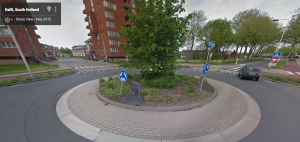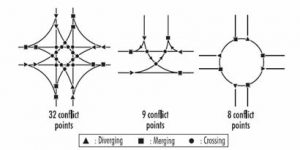Single Lane Roundabouts
Hayley Greenough and Michael Bangert-Drowns
- The main objective of the single lane roundabout is handle equal if not higher capacity than a four lane intersection and to do it in the safest way possible. Single lane roundabouts achieve that with no traffic lights and without taking up very much space. Additionally, there are also always facilities for cyclists and pedestrians alongside this type of intersection.
- One lane roundabouts are part of systematic safety because they control the speeds at the intersection. This is achieved by a small diameter and a 90 degree entry. They also reduce conflict points by getting all the traffic to flow in a similar direction. this combination of controlling speeds and getting motor traffic to follow the same path means there is complete synchronization of speed, mass, and direction. This drastically reduces chances of collisions and injuries in the intersection. Also in line with systematic safety is the idea of sharing when possible and separation when necessary. The extra bike and pedestrian facilities outside of the roundabout separates traffic by mass and speed, making the roundabout even more safe.
- This roundabout on Westlandseweg in Delft is an intersection on the main road that carries traffic from the west into Delft and onto nearby highways. Incredibly, this one-lane roundabout easily handles all of this through traffic on a 50 km road without a problem. In the additional cycle tracks and pedestrian walkways around the roundabout, the cyclists are given priority at the crossings. Still, the roundabout moves all this traffic flow through the intersection safely, and in a minimal amount of space.

- Roundabouts are appropriate treatment for any site where they can fit, and they can fit in the same space as most current 4-way intersections. They decrease conflict points from 32 to 8, and therefore also dramatically decrease the number of crashes. This fact has been proven over and over again in the Netherlands. Not only are they so much safer in comparison, they also reduce idling time of cars, congestion, and provide safe passage for all traffic, no matter if it’s motor, foot, or cycling traffic.

- A roundabout achieves its objective in several ways. Safety is four times greater than in a regular 4-way intersection due to the reduced number of conflict points and slow speeds. The single lane also eliminates any dangers associated with weaving in larger rotaries. It also increases capacity because there are no stop lights, which allows drivers to wait a significantly smaller amount of time. The slow approach to the intersection may cause slight queueing at times of higher traffic volumes, but the line of cars quickly cycles through.
- Roundabouts in the Netherlands have several features that they all share despite size or location that make them easier and safer to use than their US counterparts. These are piano keys before and after cross walks, elephants feet bordering cycle tracks, sharks teeth at the contact point with the roundabout, right angle entry, and view blocking signs in the center of the roundabout. These are consistently found at every single roundabout and it’s an interesting point that the homogenous nature of the designs makes them much more self explanatory and therefore safer.
https://www.flickr.com/photos/transportation-netherlands/28485459370/in/dateposted/
